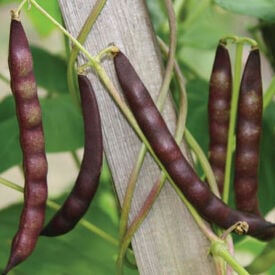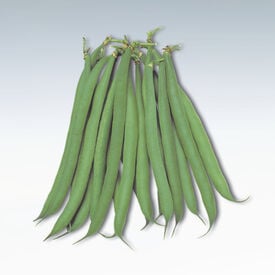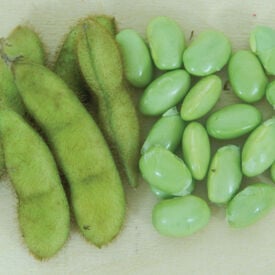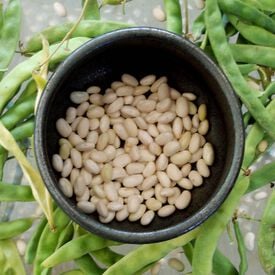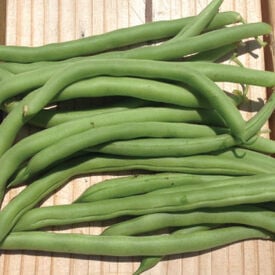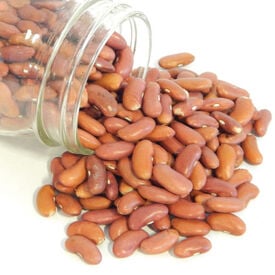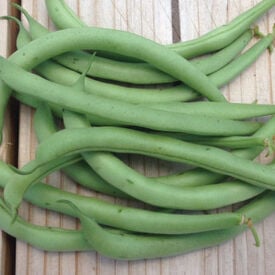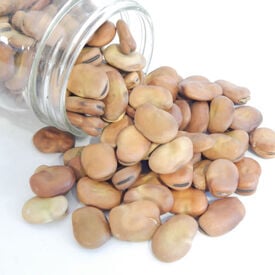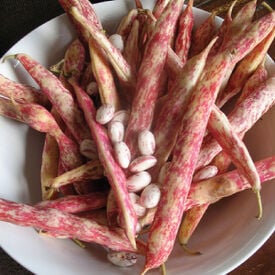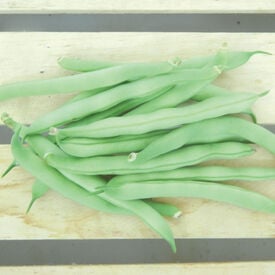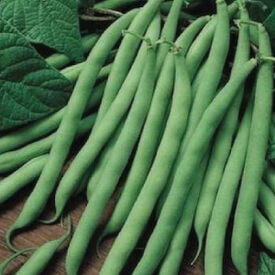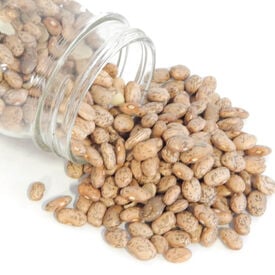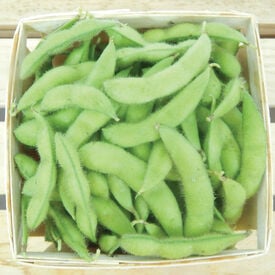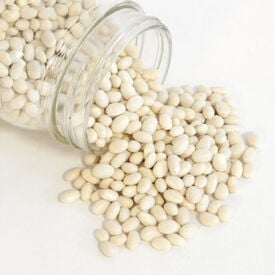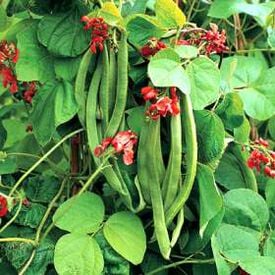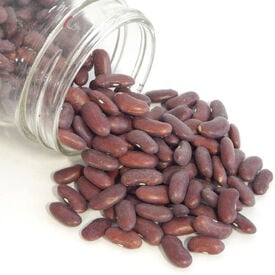Learn More
The Black Turtle Soup bean is very popular Latin favorite, that is also great in Cajun and Creole dishes. A tasty variety that grows upright with black beans inside the pod. Tall bush that keeps the bean pods off the ground.
A gourmet, dwarf French filet bean well suited for container gardens or rows. Cooks appreciate the elegance of these petite, slim beans of consistent quality. Considered one of the best flavored beans that stay tender for several days after harvest. Suitable for small space gardens.
Envy is an early harvesting edamame for shorter growing seasons. Envy produces erect bush bean plants that reach about two feet in height and produce pods each containing two to three green seeds. Edamame is a popular snack in Japan, served with beer. Due to its health benefits that other snacks do not provide, it is becoming popular in the United States.
Chivo Blanco beans (Frijol Chivo Blanco) are a cherished heirloom variety native to Mexico, known for their small, white, and slightly oval-shaped beans. These beans are valued for their creamy texture and delicate flavor, making them perfect for a wide range of traditional Mexican dishes such as soups, stews, and frijoles de la olla (beans in a pot). The name "Chivo Blanco" refers to their smooth, pale appearance, and they are often praised for their ability to cook quickly and absorb seasonings well. Grown primarily in the central and southern regions of Mexico, Chivo Blanco beans are resilient to various growing conditions, thriving in both temperate and semi-arid climates. As an open-pollinated variety, they are ideal for sustainable farming and seed-saving, helping to preserve the rich agricultural heritage of Mexico while offering a reliable, nutritious source of protein for many households.
The great northern bean is an heirloom bean variety that is perfect for drying and using in different baked dishes. Semi-vining, 24 inch plants yield a prolific quantity of flat, 5 inch pods holding 5 to 6, large white beans.
Blue Lake 274 is a popular variety of green bean (Phaseolus vulgaris) known for its exceptional taste and reliable performance in home gardens and commercial agriculture. This cultivar has a rich history, tracing its origins back to the Blue Lake region in California. Blue Lake 274 beans are beloved for their tender, crisp texture and sweet, earthy flavor, making them a favorite among gardeners and consumers alike. The Blue Lake 274 bean plant typically grows to a height of 18 to 24 inches, with a bushy, compact habit that makes it suitable for both garden beds and containers. It is classified as a bush bean, which means it doesn't require trellising or support structures. This variety is known for its relatively quick maturity, typically taking about 55 to 60 days from planting to harvest. The pods of Blue Lake 274 are long and slender, usually reaching a length of 6 to 7 inches. They are a vibrant green color and are prized for their straightness and uniformity. Blue Lake 274 beans exhibit resistance to common bean diseases such as bean mosaic virus and bean common mosaic virus, which contributes to their reliability and yield consistency. Speaking of yield, you can expect a bountiful harvest from this variety, with each row typically producing around 8 to 10 pounds of beans. For optimal growth, Blue Lake 274 beans thrive in well-drained, fertile soil with a pH level of 6.0 to 6.8. Plant them in rows with spacing of approximately 18 to 24 inches between plants. They require full sun exposure for at least 6 to 8 hours a day and should be watered consistently to keep the soil evenly moist. With the right care and conditions, Blue Lake 274 beans are sure to provide a delicious and productive addition to your garden.
The Light Red Kidney Bean is a popular kidney bean that has mild bean flavor! Excellent for chili, bean salads, and soups. Exceptional culinary quality, with silky texture and thin skin. Plants grow to medium size that are sturdy and widely adapted. Produce well anywhere in the United States.
Contender beans, scientifically known as Phaseolus vulgaris 'Contender,' are a popular variety of green snap beans that have a rich history and are prized by gardeners for their excellent flavor and productivity. Originating from the United States, Contender beans have been a favorite among home gardeners and commercial growers for many decades. This heirloom variety was first introduced in the 1940s and has since become a classic choice for those looking to cultivate delicious and reliable green beans. Contender beans typically produce uniform, straight pods that range in size from 6 to 7 inches (15 to 18 cm) in length. The pods are slender and tender, making them ideal for fresh consumption, canning, or freezing. The plants themselves are compact and bushy, reaching a height of about 18 to 24 inches (45 to 60 cm), which makes them well-suited for smaller garden spaces or container gardening. In terms of maturity, Contender beans are known for their relatively quick growth. They typically reach maturity in approximately 50 to 55 days after planting. These beans thrive in full sun and well-drained soil with good organic matter content. They are relatively easy to grow and require regular watering to maintain consistent soil moisture. Contender beans are a favorite among gardeners for their reliability, versatility, and the delectable taste of their tender green pods.
Fava Broad Windsor beans, also known as Vicia faba 'Broad Windsor,' are a classic heirloom variety with a storied history and a range of notable characteristics. Originating in the United Kingdom, this variety has been cultivated for centuries and is particularly valued for its large, hearty beans and reliable yield. The plants are characterized by their robust growth habit, reaching heights of 24 to 36 inches, with broad, dark green leaves and striking white flowers often tinged with purple. The beans themselves are large and plump, typically encased in thick, protective pods that turn from green to a rich brown as they mature. Fava Broad Windsor beans are known for their creamy, slightly nutty flavor, which becomes more pronounced when the beans are cooked. The plants generally bloom in late spring to early summer, and the beans are usually harvested about 80 to 90 days after sowing. They thrive in cool, well-drained soil and prefer full sun to partial shade. The robust nature of the plants and their ability to fix nitrogen in the soil make them a valuable crop for improving soil fertility in rotation systems. With their rich flavor, historical significance, and agronomic benefits, Fava Broad Windsor beans are a cherished choice for both traditional and modern gardens.
The Vermont Cranberry Shell bean is an incredible bean variety that can be used as a snap, shell or dry bean. Cranberry Shell stores exceptionally well. Maroon colored beans are decorated with darker red, cranberry markings. This variety dates back to the 1800s and is well-suited to short-season, cool summer climates.
Tendergreen Improved is one of the highest yielding beans around. The Tendergreen Improved bean plant is a widely adapted home garden variety. These bean plants will produce some of the highest bean yields you'll ever see. Best eaten fresh.
The Blue Lake FM-1K Pole is a stringless pole bean that is very tasty! Blue Lake beans are known for reliability, disease resistance, flavor and high yields. This is the pole version of the popular bush type that is widely planted for the canning industry. These bright green beans are straight and reach up to 7'. Perfect for those who are tired of bending over to pick beans, but still want the high yield of a bush bean.
The Pinto bean is a great tasting bean, very popular in many Mexican dishes! The Pinto bean plant is a half-runner type that produces 20 inch plants with light tan seeds with brown speckles. Eat young when green for delicious flavor. Great bean for using for refried beans.
Midori Giant is a traditional edamame variety that is eaten in oriental food. Midori Giant is an early maturing soybean with very large pods. Consistent heavy producer with over 90% two and three-seeded pods. Adaptable to all regions of the USA.
Navy beans, scientifically known as Phaseolus vulgaris, are small, oval-shaped beans that are a popular and versatile member of the legume family. They are often referred to as navy beans due to their association with the United States Navy, where they were a staple food for sailors in the 19th century. These beans have a rich history dating back to ancient times when they were cultivated by indigenous peoples in the Americas. They were later introduced to Europe by Spanish explorers and became an essential part of global cuisine. Navy beans have a mild, nutty flavor and a smooth, creamy texture when cooked. They are known for their ability to absorb the flavors of the ingredients they are cooked with, making them a favorite in soups, stews, and baked bean dishes. These beans are typically small, about half an inch in length, and are usually white or off-white in color, although there are variations with speckled or colored coats. In terms of plant characteristics, navy bean plants are relatively compact, reaching a height of about 18 to 24 inches. They have a bushy growth habit and produce small, white or lavender flowers before developing pods that contain the beans. Navy beans typically take around 80 to 90 days to reach maturity, making them a relatively quick-growing crop. They thrive in well-drained soil with good moisture retention and prefer full sun for optimal growth. Adequate spacing and support may be needed to ensure healthy plant development, and they are generally grown as annuals in most regions.
Scarlet Runner beans are a striking heirloom variety with a rich history that traces back to indigenous cultures in Central and South America. Introduced to Europe in the 17th century, these beans quickly gained popularity for both their ornamental beauty and culinary qualities. Characterized by their vigorous growth habit, Scarlet Runner plants can climb up to 10 feet or more, making them ideal for trellises or fences. The most notable feature of this variety is its vibrant scarlet flowers, which attract pollinators and add a stunning visual appeal to gardens. The pods are long and flat, typically green, maturing to a reddish hue, and are best harvested while still young and tender. Known for their rich, earthy flavor and creamy texture, Scarlet Runner beans are delicious in a variety of dishes, from stews to salads. Harvesting usually occurs in late summer to early fall, ensuring that the beans are picked before they dry out. With their ornamental charm, exceptional taste, and high productivity, Scarlet Runner beans remain a beloved choice for gardeners looking to combine beauty with culinary excellence.
Elegance beans are a refined and attractive variety of pole beans, known for their impressive combination of visual appeal and superb flavor. These beans produce long, slender pods that typically measure 6 to 8 inches in length, featuring a rich green color and a smooth, glossy texture. The plants are characterized by their vigorous growth and high productivity, with a climbing habit that benefits from sturdy supports like trellises or poles. Elegance beans are renowned for their tender, crisp texture and mildly sweet taste, making them ideal for fresh eating, steaming, or sautéing. They are also noted for their disease resistance and adaptability to various growing conditions, thriving in full sun and well-drained soil. With their elegant appearance and exceptional culinary qualities, Elegance beans are a popular choice among gardeners looking to add both beauty and flavor to their harvest.
Dark Red Kidney beans are one of the most widely used beans in North America! Dark Red Kidney is a bush variety of dried bean. Each pod contains 5 large, red kidney shaped beans. If rain threatens before your beans are totally dry, pull the whole plant up, hang upside down in your barn/garage to let them finish drying. Once dry, these beans will store for a long time! This bean is often used in Mexican food.A perfect winter food full of protein straight from your own garden.
